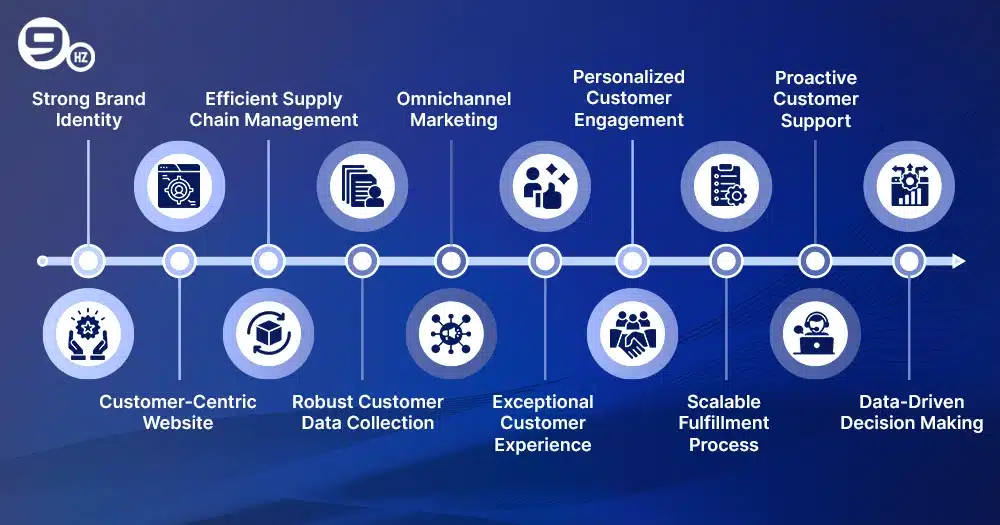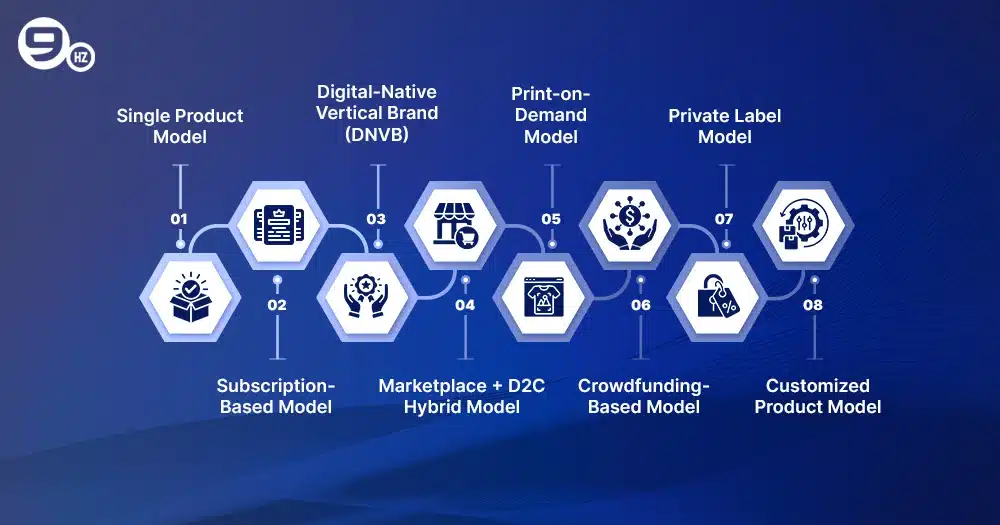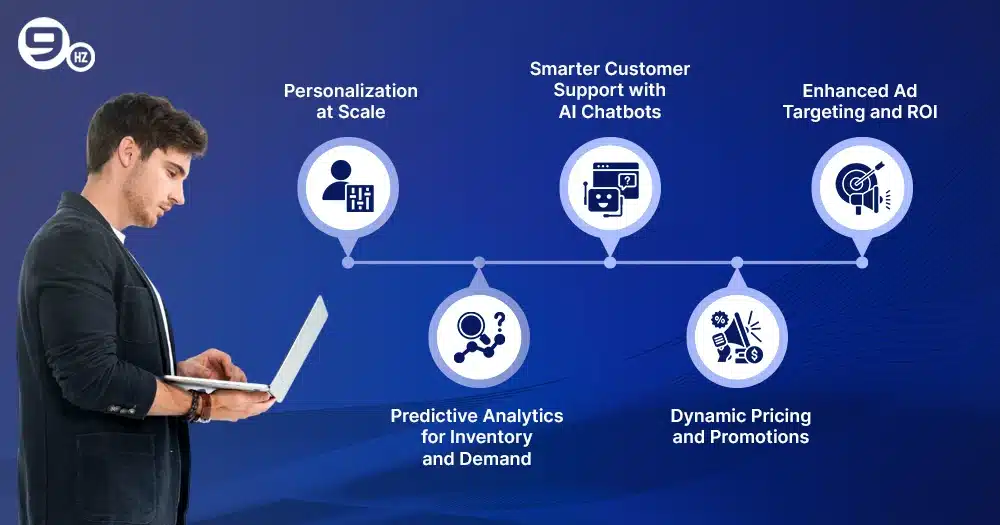Ever wondered why more brands are skipping traditional retailers and pivoting into direct customer relationships? The direct-to-consumer (D2C) movement has redefined the sales and marketing landscape for businesses in recent years. In the past few years, companies relied on intermediaries to gather their base of customers; now, with e-commerce and digital tools, they no longer need them.
According to Statista, North America’s D2C e-commerce sales are forecasted to surpass US $187 billion by 2025. This clearly implies that it is not a mere trend; rather, this is the future. The best D2C eCommerce strategy is discussed in this guide; it gives a step-by-step breakdown of everything you need to know, ranging from business models to marketing strategies and how to leverage AI for growth.
Let’s dive in and channel full power to driving your brand’s growth and delivering the best customer experiences.
What is D2C eCommerce (Direct-to-Consumer)?
D2C eCommerce is a business model where companies sell their products straightaway to end consumers from their online platforms while cutting out third-party retailers, distributors, and wholesalers. This gives them control from the absolute beginning: branding and marketing, including customer experience, packaging, and delivery.
In the past five years, this model has gained tremendous momentum among modern e-commerce brands that are looking to streamline their SCM, maximize margins, and offer phenomenal consumer experiences.
This model empowers companies to:
- Have total control over the customer journey.
- Collect valuable customer information.
- Build a direct relationship with users.
- Manage pricing, packaging, and fulfillment efficiently.
Let us take Glossier, a beauty brand that affirms a sky-high jolt of success through D2C marketing concepts implemented through a chic, content-driven website and social media, all the while bypassing department stores, which has given it control over brand voice, pricing, and packaging and has cultivated an extremely loyal customer base.
In essence, D2C e-commerce enables companies to take control of the entire customer journey, from creation to fulfillment, thereby establishing a robust and scalable business model in the current digital-first economy.
The Key Components of a Successful D2C eCommerce Strategy
To scale a successful D2C e-commerce venture, it takes more than just a good product—you need to build a business model that connects directly to your end consumers. Your company requires an integrated approach to everything that intersects with your consumer.
From customer behaviour to the way you market to your customers, all of which need to be integrated to create positive growth, develop brand and reputational capital, and remain competitive in the e-commerce marketplace.
1. Strong Brand Identity
Above all, your brand must deliver on your core values and resonate with your target consumers. A well-defined brand will create trust and engagement and drive customer loyalty. You want your brand to be first on their mind; employ the same brand across all your packaging, ecommerce stores, etc. These actions will help establish your position in the direct-to-consumer marketplace.
2. Customer-Centric Website
Your website is your online storefront, and as such, you should treat it with due diligence. A good mix of user experience, fast load times, and responsive design will provide consumers with a frictionless direct shopping experience. Using an intuitive layout and clear navigational paths will be paramount in directing the consumer through their customer journey, increasing sales, and continuing to enhance your customer acquisition. You can hire eCommerce website development company for seamless D2C website
3. Efficient Supply Chain Management
Organizing your SCM helps items reach consumers in excellent condition and on schedule. Control and visibility are needed, whether you handle fulfillment via partners or within your company. Furthermore, improving the whole client experience in your D2C eCommerce business, simplified processing may help to save expenses and improve packing quality.
Turn Your Idea into a Profitable eCommerce Store
4. Robust Customer Data Collection
An analysis of customer details helps your firm improve its marketing approach and customize items. Discovering consumer behavior, requirements, and feedback helps D2C firms change their marketing and product innovation. Long-term, data-driven initiatives boost client acquisition and engagement; therefore, they enhance their value.
5. Omnichannel Marketing
Sole dependence on one channel is inadequate in this fast-paced digital world. To reach consumers, a D2C firm uses many channels—content marketing, email marketing, and paid advertising—in concert. Diversify your touch to increase the visibility of your brand, generate leads, and maintain relationships with both fresh and returning consumers.
6. Exceptional Customer Experience
Ultimately, first on your list must be exceptional client experiences. From the very first minute, viewers come to your website to interact after they have completed a purchase; every touch counts. For your D2C e-commerce business, fast answers, simple returns, and customized service help to create strong customer connections, brand loyalty, and long-term success.
7. Personalized Customer Engagement
D2C companies succeed by making their customers feel that they matter. Use customer records to create customized content, special promotions, and suggestions for them. Nearly instant responses through email, online portals, or chatbots can create a direct bond with clients, show them you value them, and encourage more sales along with enhanced customer loyalty.
8. Scalable Fulfillment Process
When your favorite brand expands, your distribution approach should also change. Use inventory, shipping, and return systems that can manage any increase in your sales. You are able to increase your product or service supply while still keeping the quality high. An organized fulfillment process ensures customers are happy, supports the company’s image, and helps D2C firms keep everything under their own control.
9. Proactive Customer Support
Having excellent support allows your brand to stand out from competitors. Fast replies, the availability of chat, and clear FAQs help customers and earn the company’s trust. Giving proactive help to stay ahead of sales allows customers to enjoy a better experience and keeps revenue constant for direct-to-consumer businesses hoping to thrive in the long run.
Launch Your Store with Scalable, Secure, and Stunning eCommerce Solutions.
10. Data-Driven Decision Making
By relying on data, top D2C eCommerce businesses manage every action, such as launching products and creating advertising plans. By reviewing how customers act, how your sales are going, and what’s happening on your website, you can fine-tune your strategies at any time. Insights give your organization the power to decide to spend wisely, keep its resources in balance, and offer services that appeal to its client base.
Exploring Different D2C Business Models
Deciding on the right D2C business model is essential for your brand’s success. Many companies have chosen direct-to-consumer approaches in recent years, matching their strategy to who their customers are and what resources they control. If you’re a new company or a seasoned brand, knowing these concepts makes it easier to handle your investments and manage your customer service.
1. Single Product Model
In this model, only one quality product is sold directly to the buyers. It helps D2C brands target their marketing and customer recruitment with one essential tool. This platform is suitable for startups because it takes out the needless tasks, makes fulfillment easier, and connects brands with more customers—all while keeping trust and steady growth within its niche.
2. Subscription-Based Model
Products are delivered directly to consumers at the intervals they specify with the subscription model. It plays a significant function in the culinary, hygiene, and wellness markets. This business model assists organizations in maintaining client relationships, generating consistent revenue, and cultivating enduring relationships. What’s more, companies get to organize their stock, ship products efficiently, and manage their reputation.
3. Digital-Native Vertical Brand (DNVB)
DNVBs establish themselves entirely on the internet, concentrating their sales on their own websites and avoiding traditional retailers. They have complete responsibility for the products, customer information, and advertisements. DNVBs do well by offering unique experiences by using advanced technology and giving each consumer targeted products and services.
4. Marketplace + D2C Hybrid Model
In this model, companies sell through their e-commerce sites as well as various third-party online marketplaces. While this approach gives companies access to a larger audience, the brand maintains full control over pricing and branding through its direct channels. This hybrid model is great for creating additional exposure for the brand while still leveraging the benefits of D2C.
5. Print-on-Demand Model
Print-on-demand is a business model in which companies sell customized products without maintaining any inventory. This model is particularly well-suited for creative entrepreneurs and niche D2C brands. It also beneficial for those in the marketplace who are interested in establishing a new firm, as it minimizes the amount of initial investment and ambiguity associated with it.
Sell Smarter, Sell Faster – Partner with Best eCommerce Development Compnay.
6. Crowdfunding-Based Model
Crowdfunding platforms assist D2C companies in raising capital before production begins. This model gives companies the ability to raise their initial capital with many benefits of validating the demand for the product in advance. When executed strategically, crowdfunding builds a loyal customer base from day one and helps the enterprise capture customer feedback to improve its offerings and generate buzz before officially setting up its online store.
7. Private Label Model
In this, companies rebrand and sell third-party products under their brand. It is a smart D2C eCommerce strategy for companies that are interested in focusing on branding, customer service, and marketing but not manufacturing. Private-label brands can achieve faster market entry and better margins with the right approach.
8. Customized Product Model
Customers actively participate in the design or customization of the products they purchase in this scenario. It enhances client engagement and establishes a stronger emotional connection with your brand. Putting personalized products on the web-based platforms not only enhances perceived value but also provides D2C brands a competitive edge over mass-produced brands in the market.
What Are Some of the Key Benefits for Brands Using the D2C Model?
Over time, D2C has become popular for organizations, and we understand why. When you deal straight with the consumers, you gain more control, better profits, and stronger relationships. It’s time to discuss how a D2C business model gives companies an advantage in online shopping today.
More Control Over Branding and Pricing
Unlike what happens at retail stores, D2C brands have complete authority to decide on marketing, pricing, and packaging their goods. Having this autonomy, you can clearly express your brand values, use one message consistently, and offer a lower or higher price range, depending on your company’s strategy.
Access to Valuable Customer Data
As they handle the buying process themselves, D2C brands are able to collect customer information. With these insights, marketing efforts can be adapted, customer attraction becomes more effective, and recommendations can be improved that match each customer’s profile, resulting in stronger involvement over time.
Direct Relationship with Consumers
Having a direct link with your consumers increases their trust and loyalty. If your brand removes intermediaries, it can communicate to customers its own messages, reply promptly, and improve customer service.
Increased Profit Margins
If you remove middlemen such as wholesalers and retailers, your company keeps more profit compared to if you worked with them. You can also use the money to develop your products, increase your advertising, or enhance how customers shop with your brand, making D2C eCommerce stronger.
Faster Time to Market
It is often quicker to launch new products or services if you start directly through your own channels. You are able to experiment with new ideas, get user comments instantly, and improve rapidly. Thanks to this flexibility, your company can respond to changing market trends and what customers look for.
Stronger Client Engagement
When someone shops through your website or online store, they connect with your brand and not with a different company. As a result, you can offer storytelling, engaging campaigns, and personalized services to encourage regular customers.
Improved Brand Reputation
If you take care of every part of the sales process, from advertisements to packaging and delivering your products, the quality will be maintained throughout. Good services repeated over time help your company be respected and trusted by others in your sector.
Ability to Personalize the Experience
When you have access to customer information, creating a personal shopping experience is simpler. From helping customers choose products to send emails after purchase, making experiences personalized improves satisfaction, raises conversions, and sets your D2C brand apart from others.
Greater Flexibility in Marketing Strategies
Being free from retailer rules means you can check many different marketing methods on social media, on websites like Amazon or eBay, and by sending emails. With this kind of freedom, you can manage your advertising budget, refine what you say, and react fast to anything happening in the market.
Efficient Inventory and Supply Chain Management
Using direct sales, you can view and track all your stock. You can connect your SCM activities to real customer needs, helping you minimize waste, lower storage charges, and be more effective in the way you operate.
Stronger Community and Brand Advocacy
Many D2C companies create communities among those who share the same values or lifestyle. By talking to your customers in person, you can form followings that help advertise your company on places such as Instagram, TikTok, and Facebook.
Better Testing and Innovation Opportunities
As D2C companies engage directly with users, they find out which packaging works best, gather opinions from customers, and help launch products with little delay. Because Agile is in real-time, you are able to keep evolving and meet the current requirements of your consumers.
Evaluating Potential Challenges and Risks in D2C eCommerce Strategy
The direct-to-consumer (D2C) way of doing business has its advantages, yet it also brings certain problems. Dealing with logistics, increasing ad prices, and more, brands need to use effective strategies. Learning about these risks is necessary to create a secure business structure, keep customers happy, and manage all aspects of a company’s image.
High Customer Acquisition Costs
It is more expensive to gain customers in a crowded D2C e-commerce landscape. To gain customers, brands mostly have to depend on ads and advertising through influencers, if there are no third-party retailers involved. For instance, Dollar Shave Club used millions in video marketing to help grow its user base. If you use SEO and social media from the start, you’ll spend less money on getting new users over time.
Complex Logistics and Fulfillment
Setting up your own ways to ship, package and return items isn’t easy. It’s hard for many new direct-to-consumer brands to keep track of their stock and make orders on time. A true-life example is Glossier, whose customers protested when their packages were not delivered promptly during the company’s fast-growing period. With increasing consumer preferences, an SCM and fulfillment strategy that can grow is essential.
Website and Platform Maintenance
Grown stores need tech upgrades, secure protection, and improvements for better performance. Allbirds and numerous other D2C sites had difficulties functioning due to increased website visits on Black Friday. This situation can damage the brand’s reputation and reduce client engagement.
Limited Product Discoverability
In contrast to online marketplaces, which have a built-in audience, D2C brands need to work harder for visibility. As a case in point, a small sustainable apparel brand had trouble generating traffic to its site without tapping into the Amazon price grab.
To address this issue, capitalize on strong content marketing and advertising strategies and digital channels such as social media to enhance product awareness and expand your reach.
Customer Trust and Retention
Establishing trust without retail partners can be a challenge. Customers who are unsure about a D2C brand’s authenticity or quality may be hesitant to make a purchase from an unfamiliar online store.
Use high-quality content to educate and inform consumers about your offering while also providing review credits, product details, and a solid return policy, which are just a few solid measures to improve credibility, raise retention, and increase client engagement.
Scaling While Maintaining Quality
As D2C brands grow, it becomes increasingly difficult to deliver consistent levels of both product and service quality. As demand grew, Casper, the mattress startup, battled with its commitment to client experience. Quick growth might result in low-quality packing, delayed delivery, and generally negative consumer experiences.
Overdependence on a Single Channel
By depending on only one channel, such as hired advertising or Instagram, you are putting your company at risk. You can’t know how ad price hikes or algorithm changes will affect sales until they happen.
Take MVMT Watches as an example – the company was so reliant on Facebook’s ads that its growth flatlined after ad costs went way up. A balanced strategy using email, SEO, and multiple social platforms is your best bet for stability over the long haul and to cover more ground.
How AI Helps Your D2C Platform?
How D2C e-commerce platforms do business has been greatly changed by the rise of Artificial Intelligence (AI). By using AI, brands can keep customers more engaged, deliver goods more efficiently, and base their actions on data. Using customer information and automated tools, D2C companies can attract more customers, manage processes more easily and ensure loyal and growing customers.
1. Personalization at Scale
It uses the data from customers to provide carefully chosen product suggestions, targeted emails, and content that fits their interests. For instance, a skincare brand can give recommendations for routines according to what products a person has bought. More personal suggestions in email marketing improve how customers interact with your brand, support your sales, and make people more likely to use your site or app for shopping.
Real-Life Use Case: Based on quiz answers and what you have bought at Sephora, AI helps offer you personalized recommendations. Going straight to consumers invites them to engage, makes them want to come back, and allows them to choose how they make their purchases.
2. Predictive Analytics for Inventory and Demand
AI technology can analyze data and predict both stock levels and what customers will want. As a result, brands can operate their SCM smoothly, avoid having too many or too few products, and save money. By using seasonal demand, a fashion retailer can improve how it handles inventory, which makes customers content.
Real-Life Use Case: Using AI, Stitch Fix manages to determine what users like and predict future sales trends. As a result, there is less waste in stock and customer always find what they need when shopping with that company.
3. Smarter Customer Support with AI Chatbots
Chatbots and virtual assistants use AI to solve customer problems immediately and at any time of day. As a result, customers enjoy greater engagement and human agents face a lesser workload. Warby Parker uses chatbots to guide clients through their purchases and shipping, providing them with faster solutions and better control over support.
Real-Life Use Case: Using chatbots, Hims allows its users to book appointments and look up products online. With this, customers enjoy a convenient journey, customer service improves and the brand’s online shoppers continue to use different platforms.
4. Dynamic Pricing and Promotions
AI is used to keep an eye on market trends, how customers buy and competition’s prices to help set live and accurate pricing. As a result, D2C brands can charge customers competitively while maintaining their profit margins. An electronics company could use demand trends to set its product prices, boost sales, and build a strong brand reputation.
Real-Life Use Case: Nike’s site uses AI technology to change the price of products automatically. As a result, brands can manage demand changes easily and sell directly to customers for the best profit.
5. Enhanced Ad Targeting and ROI
It uses data to determine which types of advertising get the best results for particular groups of customers. Better control in targeting on social media platforms and search engines lets brands lower the costs of attracting customers and improve conversions. By using these methods, you make sure your advertising is as rewarding as possible for your company.
Real-Life Use Case: Glossier uses AI technology to help target its ads according to what customers want. For this reason, D2C Beauty has cut acquisition expenses, raised returns, and reached more potential buyers on different online channels.
Steps of Implementing D2C eCommerce Strategy
Over the last several years, many brands have adopted the direct-to-consumer channel to take more control of e-commerce. Simply starting an online shops does not mean you are a successful D2C e-commerce business.
Your company does need a comprehensive business strategy around D2C that connects with your target audience, ensures an uncomplicated way to do deals with you, and creates the most positive customer experience through all touchpoints. To implement your DTC strategy, follow the steps below:
Step 1: Know Your Niche and Audience
First, we need to start with thorough market research to understand your niche, target customers, and analyze preferences, behaviors and competitors to nail down your positioning.
Example: An eco-friendly pet brand employed social listening and surveys to create products based on sustainable pet care. Therefore, they were able to acquire customers and utilize retention methods considerably faster than traditional models.
Step 2: Define a Clear Value Proposition
Your value proposition should clarify why your customers need to shop directly from you. Whether it is a lower price, quality, convenience, or another factor, please ensure it is clearly defined on your website and marketing materials.
Example: Warby Parker upended the traditional retail prescription eyewear experience by selling directly and at transparent prices with home try-ons, adding a ton of value to the do-it with one brand.
Step 3: Build a High-Performing Website
Your website represents your brand to the world. Improve site performance, its look on mobile devices, and its user-friendliness. Reviews, how-to articles, and clear CTAs will enhance how your customers experience your website. When a site is strong, it supports your brand image and makes it simple for interested users to complete a purchase.
Step 4: Plan Fulfillment and Supply Chain
Ensure your fulfillment strategy is flexible and depends on either trusted partners or in-house staff. See that your inventory levels are correct and that deliveries are on schedule to fulfill what your customers expect. A branded box adds value to unboxing and helps boost your company’s identity.
Step 5: Choose the Right Marketing Mix
Advertise your brand, use SEO, send emails, and work with influencers. End consumers and loyal customers are often reached and built through Instagram and TikTok.
Example: Instead of depending on big retailers, Glossier used customers’ posts and feedback to boost its growth.
Step 6: Focus on Customer Support and Retention
Ensure you give quick help and make returns simple to show you care about your customers. Use both live chat and post-sale emails to improve their relationship with customers and help them return to your store. Satisfied clients routinely recommend you, which increases your client base without effort.
Step 7: Use Data to Personalize and Improve
Use customer data to fine-tune product offerings, customize emails, and improve pricing. The process can be automated, and decision-making can be enhanced with AI tools.
Example: A coffee brand utilized data to offer customized subscriptions and has achieved higher retention and predictable sales results.
Step 8: Stay Agile and Innovate
To keep making progress, it is important to routinely trial new products, examine industry trends, and refresh your offerings. Organizing your catalog into a set of validated products versus new products should help mitigate risk while still allowing growth. Ensuring you bring new, innovative products to market also preserves and strengthens the competitive stakes in your business model.
Step 9: Expand Channels Strategically
While your own platform is the core of your company, what about real estate marketplaces online to provide additional visibility, as long as they don’t take away your brand value? It’s finding the right balance between visibility and having total control over the customer information, pricing, and experience.
Step 10: Build a Community Around Your Brand
Elevating the user’s experience with your brand doesn’t end with the sale. Offering behind-the-scenes or storytelling content, early access to products, etc. All of this reinforces the brand community, creating loyalty and advocates. The stronger your community becomes, and the more direct your relationship with end users is, the more value you build and the better you can grow your company for future long-term sustainable scale in D2C e-commerce.
Key Takeaways for Successful D2C Brands
21st-century ecommerce brands focus on reaching consumers who prefer to buy directly from the maker on the Internet or social apps. Owing to this model, the company can control customer behaviour, brand recognition, and delivery. With an investment in customer details, improved marketing, and top customer service, a company can build and maintain a loyal group of buyers and outperform competitors.
- Create your unique brand image and own it.
- Gather information and analyze it about your customers.
- Offer excellent customer service all across the experience.
- Ensure you are in charge of your SCM and how deliveries are made.
- Keep updating your marketing methods.
- AI tools can make services more personally tailored and speed up processes for users.
- Remain responsive to new changes happening in the industry.
Don’t forget that the strongest D2C brands focus on developing relationships instead of just focusing on one-time purchases.
Conclusion
D2C eCommerce is no passing fashion but a serious change in how companies sell to their customers. Selling has empowered brands to fully control marketing, engaging customer pricing, and data-gathering methods.
The challenges of fulfillment, customer acquisition costs, and technological integration exist. These aspects can be dealt with if approached correctly with the right mindset and tools. By establishing a structured business model, investing in AI, and delivering value, your brand can thrive amid the direct-to-customer environment.
If your company seeks to help brands build deeper connections while enhancing margins and controlling their own destiny, then it is time to try out our D2C e-commerce services. Using unique solutions, flawless user experiences, and end-to-end tech support catered to your brand goals, NineHertz helps you start and grow your D2C e-commerce business.
FAQ on D2C Ecommerce Strategies
1. What is a D2C marketing strategy?
The main goal of D2C marketing is to reach customers by offering products through online shops. It focuses on giving personalized service, using social media and analyzing customer information to boost how much people are involved, how loyal they are and how much they spend.
2. How can I increase my D2C sales?
You can grow your D2C sales by developing your search and advertising efforts, using customer information to tailor how you connect, and including personalized promotions and campaigns on various social media websites.
3. What is the GTM strategy for a D2C brand?
A good D2C GTM strategy looks at who the customers are, picks the correct eCommerce site, uses helpful online tactics and has the warehousing setup ready for immediate consumer experiences.
4. Why do some D2C businesses fail?
One reason many D2C businesses fail is that it’s too expensive to acquire customers, fulfillment isn’t efficient, and their marketing is too limited. When a company doesn’t oversee logistics and brand positioning, it becomes tough to sustain growth and keep customers.
Great Together!












